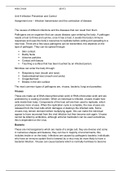Millie O’Neill 185473
Unit 9 Infection Prevention and Control
Assignment one – Infection transmission and the contraction of disease
The causes of different infections and the diseases that can result from them
Pathogens are an organism that can cause disease upon entering the body. A pathogen
needs a host to thrive and survive, once it has a host, it avoids the body’s immune
responses and uses the body’s resources to replicate before exiting and spreading to a
new host. There are a few ways pathogens can be transmitted, this depends on the
type of pathogen. They can be spread through:
Skin contact
Bodily fluids
Airborne particles
Contact with faeces
Touching a surface that has been touched by an infected person.
Microbes can enter the body through:
Respiratory tract (mouth and nose)
Gastrointestinal tract (mouth oral cavity)
Urogenital tract
Breaks in the skin surface
The most common types of pathogens are, viruses, bacteria, fungi and parasites.
Viruses
These are made up of DNA (deoxyribonucleic acid) or RNA (ribonucleic acid) and are
protected by a coating of protein. When an individual is infected, viruses invade host
cells inside their body. Components of the host cell are then used to replicate, which
produces more viruses. When the replication cycle is complete, the new viruses are
released from the host cells which damages or destroys the infected cells. Some
viruses may remain dormant before multiplying again, this can make the individual
appear to have recovered from the viral infection but then become sick again. Viruses
cannot be killed by antibiotics, although antiviral medication can be used sometimes,
this is dependent on the virus.
Bacteria
These are microorganisms which are made of a single cell, they are diverse and come
in numerous shapes and features, they can live in majority of environments, this
includes inside or on the body. Infections are caused by pathogenic bacteria. Individuals
who have an immune system that is lowered by a virus may be more likely to have a
bacterial infection. Viruses can cause bacteria which is normally harmless to become
, Millie O’Neill 185473
pathogenic. Bacterial infections can be treated with antibiotics, although some have
become resistant which makes them hard to treat.
Fungi
Although there are millions of fungal species, only about 300 are known to cause
sickness. Fungi can be found indoors, outdoors and on human skin, they can cause
infection when they over grow. As fungi contain a nucleus and other things which are
protected by a membrane and a thick cell wall, they are harder to kill.
Parasites
These are organisms that live in or on a host and feed from or at the expense of the
host. There are three main types of parasites that cause disease to humans, these are:
Protozoa – single-celled organisms that live and multiply in the body
Helminths – larger, multi-celled organisms that live inside or outside the body and
are commonly known as worms
Ectoparasites – multi-celled organsisms that live on/feed off your skin, this
includes insects such as ticks and mosquitos.
These are spread through contaminated soil, water, food, blood, sexual contact and
insect bites.
Diseases that are caused by these
Viruses can cause numerous infections, majority of these are contagious.
Common cold
Flu
Warts
Meningitis
Oral/genital herpes
Chickenpox/shingles
Measles
Viral gastroenteritis
Hepatitis
Yellow fever
Dengue fever
HIV and AIDS
Bacteria
Strep throat
Urinary tract infection
Bacterial gastroenteritis
Bacterial meningitis





